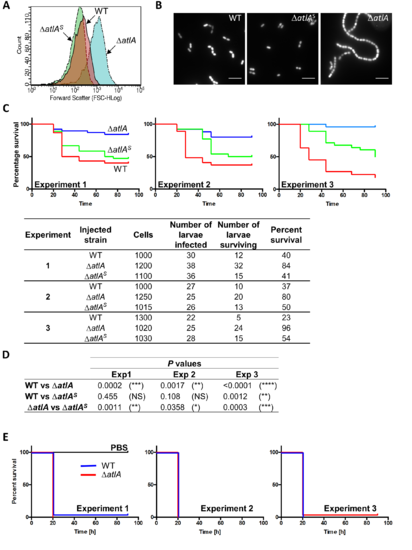- Title
-
Bacterial size matters: Multiple mechanisms controlling septum cleavage and diplococcus formation are critical for the virulence of the opportunistic pathogen Enterococcus faecalis
- Authors
- Salamaga, B., Prajsnar, T.K., Jareño-Martinez, A., Willemse, J., Bewley, M.A., Chau, F., Ben Belkacem, T., Meijer, A.H., Dockrell, D.H., Renshaw, S.A., Mesnage, S.
- Source
- Full text @ PLoS Pathog.
|
E. faecalis long cell chains are less virulent in the zebrafish model of infection and more prone to phagocytosis than diplococci. A. Survival of zebrafish larvae (n>20) following infection with E. faecalis OG1RF (WT) and atlA isogenic deletion mutant before (ΔatlA) and after (ΔatlAS) sonication to disperse long chains. Statistical significance was determined by Log-rank test; **P = 0.0011; *** P = 0.0002; NS, P>0.05. B. Quantification of E. faecalis uptake by zebrafish phagocytes. Embryos were infected with 1,200 E. faecalis cells expressing GFP and fixed in 4% paraformaldehyde 1.5h post infection. Phagocytes were immunolabelled using rabbit anti L-plastin antibodies and detected with goat anti-rabbit antibodies conjugated to Alexafluor 647. Fluorescent bacteria and phagocytes were imaged by scanning confocal microscopy. The area of GFP fluorescence signal outside and inside phagocytes was measured using a dedicated Fiji plugin. The ratio of GFP fluorescence area outside to inside phagocytes was used to quantify bacterial uptake. Phagocytosis was significantly higher for long chains (ΔatlA) when compared to their sonicated counterparts (ΔatlAS) (**P = 0.0098) or the wild-type cells (*P = 0.0438). No difference in uptake was found between short chains corresponding to the wild-type or sonicated ΔatlA mutant (NS, P>0.05). Representative images of phagocytes (magenta) following infection with ΔatlA, sonicated ΔatlAS and wild-type OG1RF cells shown. Phagocytes labeled with L-plastin appear in magenta, GFP-producing bacteria in green. Scale bar is 20μm. C. Survival of phagocyte-depleted zebrafish larvae (n>20) following injection with E. faecalis OG1RF (WT) or ΔatlA. D. Pairwise comparisons of phagocytosis indexes corresponding to E. faecalis OG1RF and ΔatlA uptake by human monocyte-derived macrophages (MDM). Statistical significance was determined by paired t-test; ΔatlA cells were more efficiently phagocytosed by MDM than WT cells (**P = 0.0024; n = 7). |
|
Analysis of the virulence of E. faecalis ΔatlA mutants forming long chains. A. Comparison of median forward scattered (FSC) light values corresponding to the cell chain lengths of WT (OG1RF), ΔatlA and sonicated ΔatlA (ΔatlAS) strains. B. Light microscopy images showing cell chain lengths of WT and ΔatlA derivatives expressing cytoplasmic GFP. C. Survival of zebrafish larvae (n>20) following infection with E. faecalis OG1RF (WT) and atlA isogenic deletion mutant before (ΔatlA) and after (ΔatlAS) sonication to disperse long chains. The results corresponding to three independent experiments are shown. For each experiment, the number of cells injected (determined after sonication) is indicated. D. P values resulting from pairwise comparisons using the log rank test. E. survival of phagocyte-depleted zebrafish larvae following injection with 1250 cells of E. faecalis OG1RF (WT) or ΔatlA. |
|
Analysis of the impact of mild sonication on E. faecalis OG1RF virulence. A. Survival of zebrafish larvae (n>20) following infection with E. faecalis OG1RF (WT) and OG1RF sonicated (WTS) cells. The results corresponding to three independent experiments are shown. For each experiment, the number of cells injected (determined after sonication) is indicated. B. P values resulting from pairwise comparisons using the log rank test. |


